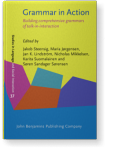Chapter 14
Discussion
Where are we now and what are the next steps toward an
Interactional Grammar?
The chapters of this volume have taken important first
steps toward the ultimate goal that all contributors to this volume
share: The creation of comprehensive grammars of talk-in-interaction
in specific languages, which are based on, and true to, how language
is used in interaction. In this discussion chapter, we extract the
main new findings of the contributions to the volume, discuss how
these findings might challenge received notions used in grammars,
and make suggestions about the next steps that should be taken
toward a truly interactional grammar.
Article outline
- 1.Expansion of the grammar
- 1.1Interaction-specific formats and uses of formats
- 1.2Context and external syntax
- 1.3Social action
- 1.4Prosody and embodied actions
- 1.5Projection, emergence, and Collaborative Grammar
- 1.6Identities, settings, larger activities, participation
framework, and positioning
- 2.Methodology, data and grammatical terminology
- 2.1Discovery procedures
- 2.2Interactional setting and grammatical description
- 2.3Grammatical concepts
- 3.Practicalities of grammar writing and applications
of an
Interactional Grammar
- 3.1The structure of an Interactional Grammar
- 3.1.1Overall organization
- 3.1.2Contents: Action-to-Grammar and Grammar-to-Action
- 3.1.3Additional dimensions
- 3.2The intended users of an Interactional Grammar
- 4.Possible next steps
-
References
This content is being prepared for publication; it may be subject to changes.
